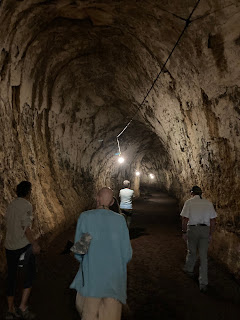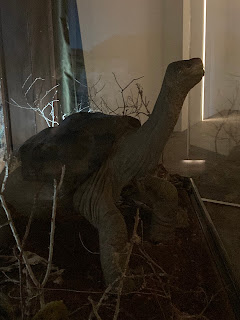During the night, the boat motored around the island of Santa Cruz, from the northern tip around to the southern, and dropped anchor at the port of Ayora. This town of about 20,000 is spread out around the harbor, which we shared with dozens of other tour boats, and at least one large cruise ship of 100 passengers (the legal maximum for any single ship in the Galapagos).
It’s the home of our tour director, Alejandra, and of many of the crew members. One did not have to understand Spanish to know that they were all excited to be near to family and to have cellular phone service once again.
We boarded the zodiac, and after much pointing and conversation in Spanish between Alejandra and the driver, we navigated to a very secluded, almost invisible inlet some distance from the main harbor. Here we found four sailboat moored parallel to one another. Alejandra explained that her family owns two of them.
One, the smaller boat, is a very old wooden craft that they bought some years ago from a Belgian fellow who was resident here, and who had built it. It has the distinction of being the very first boat registered in the Galapagos, with the license number 01-00001 painted on its side.
Though it is an antique that requires a great deal of maintenance, the family uses this boat as a home away from home, sometimes spending the night on board — especially during the pandemic periods of isolation. It has both wind and solar generators, with refrigerator and even a small electric water desalination unit aboard.
The other boat is a larger craft, 49 feet long, that they purchased from salvage. It is in rough shape, but her husband’s hobby is working on both boats, so it is a work in progress. The problem is that it is currently tied up in legal red tape, because the Ecuadoran government discourages private ownership of larger boats.
One of the primary ways that traffic in the national park is regulated is by limiting the number of commercial boat permits. Even though this family’s dream is to sail to French Polynesia, the government’s fear is that they will use it for tourists. Thus, they are having great difficulty getting the necessary permits for it.
The zodiac continued back into the main harbor and we disembarked at a very prosperous-looking private residence, right on the water, that is the home of one of Alejandra’s friends and her husband — marine biologists and artists. We were seated on the front porch, but did not get a chance to see the home.
The woman explained that, in the work as biologists, they have become very alarmed at the pervasive presence of plastic in the environment — not only along the shore, but also far inland. Birds and other animals either get trapped in the plastic, or pick it up as nesting material, or simply mistake it for food. They then carry it into places that are uninhabited and that normally would have had no pollution.
This couple has obtained equipment from the Netherlands that melts retrieved plastic and extrudes it into molds to make key rings, magnets, jewelry, coasters, and other souvenirs. They thus recycle single use plastics more durable items.
Although the scale of what they are doing is very small, and by itself makes only an infinitesimal dent in a much, much larger problem, their operation serves an educational purpose, raising awareness of the dangers of single use plastics.
Water taxi |
When our visit was complete, Alejandra hailed a water taxi, which for 80 cents U.S. for each of us, carried us across the harbor to the main dock that is used by all of the cruise boats. The taxi dropped us in what is essentially the center of town, with a “supermarket” and a church, as well as a little park with a playground.
We had no time to linger, because we were immediately picked up by a small bus that might have held 18 people if we squeezed in. Fortunately, it was just the nine of us plus Alejandra. We did pick up one more, however. After a brief tour of the main drag, pointing out some of the best shops and coffee houses, Alejandra directed the driver to her own home, where she dropped off some of her personal things and picked up her 12-year-old daughter, Olivia.
Olivia accompanied us on the half hour journey up into the “highlands.” One should note that climbing even a few hundred feet above sea level constitutes a great height in these parts. Nevertheless, it was startling to see how green the landscape became, going from desert to grass and trees very quickly. There was also agriculture here, primarily beef cattle and dairy cows grazing.
Our first stop was a lava tube, a natural volcanic cavern some 400 meters in length, and at least 10 to 12 feet, or more in some places, in diameter. The islands are rife with these, most still undiscovered. The most common means of discovery is when a cow disappears and is later located in a sinkhole.
From here, the bus took us a very short distance to a “turtle ranch.” No turtles are actually raised here. It is just a piece of property that happens to be located in the midst the natural habitat for the Giant Tortoise.
The tortoises are not kept — they come and go as they please. But these huge land turtles are so abundant that there are always a great many here to see.
The “ranch” makes its money primarily from a restaurant and gift shop frequented by tourists who come to see the tortoises. They served us a pretty decent lunch, and they had free wi-fi for the first time in a week. However, it was so slow that all I could receive were a couple of short text messages.
The bus took us back to town and dropped us once again on the public pier, where several “homeless” sea lions had taken over some of the benches that were supposed to be for waiting passengers.
The zodiac returned us to the boat for a hour or two of siesta, because almost all of the shops in town close from noon to 3 p.m. for siesta, as well.
We returned to town, and because it was beastly hot, Alejandra arranged taxis to take us to our destination, the Darwin Center. This research facility focuses on the Giant Tortoises and operates a breeding program for endangered species.
There, we learned about “Super Diego,” a tortoise from the San Diego Zoo who was sent back to the Galapagos at an age of more than 100 years, and managed to father more than 700 offspring. We also saw the taxidermied remains of “Lonesome George,” who was the last of his now extinct breed.
Lonesome George, stuffed |
Like tortoises released into the wild after having been bred in captivity, Alejandra released us to free time in Puerto Ayora. We walked back to town, seeing nothing but tourist shops. It’s a typical tourist town.
But when we arrived at a local microbrewery, we stopped in to cool off. We were pleasantly surprised that the beer was good and the prices were not unreasonable. The open air seating on the top floor gave us a great view of the harbor, shade, and a cooling breeze.
Back aboard the boat, we had a bit of time to get ready for dinner. The captain had sent our group a complimentary bottle of red wine, so we got to enjoy a glass with our meal. Following dinner, Alejandra reviewed the week with a trivia quiz that I won. Writing this blog helped fix various events and places in my memory.

















No comments:
Post a Comment